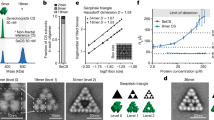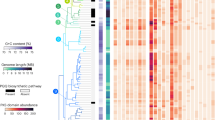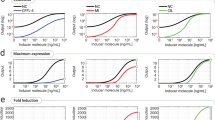Abstract
Annotated genome sequences1,2 can be used to reconstruct whole-cell metabolic networks3,4,5,6. These metabolic networks can be modelled and analysed (computed) to study complex biological functions7,8,9,10,11. In particular, constraints-based in silico models12 have been used to calculate optimal growth rates on common carbon substrates, and the results were found to be consistent with experimental data under many but not all conditions13,14. Optimal biological functions are acquired through an evolutionary process. Thus, incorrect predictions of in silico models based on optimal performance criteria may be due to incomplete adaptive evolution under the conditions examined. Escherichia coli K-12 MG1655 grows sub-optimally on glycerol as the sole carbon source. Here we show that when placed under growth selection pressure, the growth rate of E. coli on glycerol reproducibly evolved over 40 days, or about 700 generations, from a sub-optimal value to the optimal growth rate predicted from a whole-cell in silico model. These results open the possibility of using adaptive evolution of entire metabolic networks to realize metabolic states that have been determined a priori based on in silico analysis.
This is a preview of subscription content, access via your institution
Access options
Subscribe to this journal
Receive 51 print issues and online access
$199.00 per year
only $3.90 per issue
Buy this article
- Purchase on Springer Link
- Instant access to full article PDF
Prices may be subject to local taxes which are calculated during checkout




Similar content being viewed by others
References
Blattner, F. R. et al. The complete genome sequence of Escherichia coli K-12. Science 277, 1453–1474 (1997)
Drell, D. The Department of Energy Microbial Cell Project: a 180° paradigm shift for biology. OMICS 6, 3–9 (2002)
Covert, M. W. et al. Metabolic modeling of microbial strains in silico. Trends Biochem. Sci. 26, 179–186 (2001)
Selkov, E., Maltsev, N., Olsen, G. J., Overbeek, R. & Whitman, W. B. A reconstruction of the metabolism of Methanococcus jannaschii from sequence data. Gene 197, GC11–GC26 (1997)
Overbeek, R. et al. WIT: integrated system for high-throughput genome sequence analysis and metabolic reconstruction. Nucleic Acids Res. 28, 123–125 (2000)
Karp, P. D. et al. The EcoCyc database. Nucleic Acids Res. 30, 56–58 (2002)
Gombert, A. K. & Nielsen, J. Mathematical modelling of metabolism. Curr. Opin. Biotechnol. 11, 180–186 (2000)
Tomita, M. et al. E-CELL: software environment for whole-cell simulation. Bioinformatics 15, 72–84 (1999)
Fell, D. Understanding the Control of Metabolism (Portland, London, 1996)
Schuster, S., Fell, D. A. & Dandekar, T. A general definition of metabolic pathways useful for systematic organization and analysis of complex metabolic networks. Nature Biotechnol. 18, 326–332 (2000)
Schilling, C. H. et al. Genome-scale metabolic model of Helicobacter pylori 26695. J. Bacteriol. 184, 4582–4593 (2002)
Edwards, J. S. & Palsson, B. O. The Escherichia coli MG 1655 in silico metabolic genotype: its definition, characteristics, and capabilities. Proc. Natl Acad. Sci. USA 97, 5528–5533 (2000)
Varma, A. & Palsson, B. O. Stoichiometric flux balance models quantitatively predict growth and metabolic by-product secretion in wild-type Escherichia coli W3110. Appl. Environ. Microbiol. 60, 3724–3731 (1994)
Edwards, J. S., Ibarra, R. U. & Palsson, B. O. In silico predictions of Escherichia coli metabolic capabilities are consistent with experimental data. Nature Biotechnol. 19, 125–130 (2001)
Palsson, B. O. The challenges of in silico biology. Nature Biotechnol. 18, 1147–1150 (2000)
Edwards, J. S., Ramakrishna, R., Schilling, C. H. & Palsson, B. O. Metabolic Engineering (eds Lee, S. Y. and Papoutsakis, E. T.) (Marcel Dekker, New York, 1999)
Bonarius, H. P. J., Schmid, G. & Tramper, J. Flux analysis of underdetermined metabolic networks: The quest for the missing constraints. Trends Biotechnol. 15, 308–314 (1997)
Varma, A. & Palsson, B. O. Metabolic flux balancing: basic concepts, scientific and practical use. Bio/Technology 12, 994–998 (1994)
Wiechert, W. Modeling and simulation: tools for metabolic engineering. J. Biotechnol. 94, 37–63 (2002)
Schilling, C. H., Edwards, J. S., Letscher, D. & Palsson, B. O. Combining pathway analysis with flux balance analysis for the comprehensive study of metabolic systems. Biotechnol. Bioeng. 71, 286–306 (2000)
Edwards, J. S., Ramakrishna, R. & Palsson, B. O. Characterizing the metabolic phenotype: a phenotype phase plane analysis. Biotechnol. Bioeng. 77, 27–36 (2002)
Weikert, C., Sauer, U. & Bailey, J. E. Use of a glycerol-limited, long-term chemostat for isolation of Escherichia coli mutants with improved physiological properties. Microbiology 143, 1567–1574 (1997)
Acknowledgements
We thank L. Ramos, J. DiTonno, S. Fong, J. Marciniak, N. Short and H. Bialy for technical assistance and for reviewing the manuscript. We acknowledge funding support from the National Institutes for Health and the National Science Foundation, and the Department of Energy Office of Biological and Environmental Research.
Author information
Authors and Affiliations
Corresponding author
Ethics declarations
Competing interests
We have filed a patent about the subject matter of this paper which has been licensed to Genomatica, Inc., a University of California at San Diego spin-off company. The University of California at San Diego, J.S.E. and B.Ø.P. hold interests in this company.
Rights and permissions
About this article
Cite this article
Ibarra, R., Edwards, J. & Palsson, B. Escherichia coli K-12 undergoes adaptive evolution to achieve in silico predicted optimal growth. Nature 420, 186–189 (2002). https://doi.org/10.1038/nature01149
Received:
Accepted:
Issue Date:
DOI: https://doi.org/10.1038/nature01149
This article is cited by
-
Dynamic proteome trade-offs regulate bacterial cell size and growth in fluctuating nutrient environments
Communications Biology (2023)
-
Competition and evolutionary selection among core regulatory motifs in gene expression control
Nature Communications (2023)
-
Emergent Lag Phase in Flux-Regulation Models of Bacterial Growth
Bulletin of Mathematical Biology (2023)
-
Genome-scale modeling of Chinese hamster ovary cells by hybrid semi-parametric flux balance analysis
Bioprocess and Biosystems Engineering (2022)
-
Modeling photosynthetic resource allocation connects physiology with evolutionary environments
Scientific Reports (2021)
Comments
By submitting a comment you agree to abide by our Terms and Community Guidelines. If you find something abusive or that does not comply with our terms or guidelines please flag it as inappropriate.



